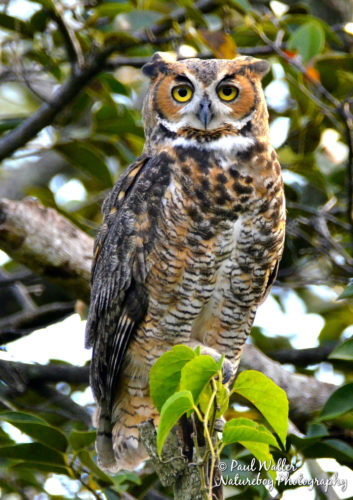Great Horned Owl
The majestic Great Horned Owl, Bubo virginianus, is a delightful sight to behold. This bird of prey is common throughout Florida and can be found in forests, wetlands, yards, and cities. The piercing yellow eyes of the Great Horned Owl do not move in their sockets. The owl will swivel its neck more than 180 degrees in both directions to see its surroundings. You have most likely heard the owl’s unmistakable, hauntingly deep hooting voice.
Female Great Horned Owls lay 1 brood each year of 1-4 eggs in a nest in a tree. The nest is made of sticks and is usually one built by another species. The owls may line the nest with leaves, fur and feathers from their prey, or feathers plucked from their own chests. They may also nest on the ground, in the cavity of a tree, in abandoned human structures, or on a platform designed especially for them.
Great Horned Owls have talons that exert up to 28 pounds of force when used to sever the spines of captured prey. Meals consist of frogs, rats, squirrels, crows, doves, and more. They will snack on insects, scorpions, and reptiles. Great Horned Owls also prey on animals larger than themselves including other owls, Osprey, and falcons.
Great Horned Owls mate for life. The couple defends their territory together but they roost separately. Look for them diving for prey near dawn and dusk. You may also witness raptors, crows, or songbirds loudly calling them, pecking at them, and dive-bombing them with just cause. As long as Great Horned Owls occupy their territory, the other birds risk becoming their prey.
According to the North American Breeding Bird Survey, Great Horned Owl populations declined by 33% between 1966 and 2015 due to over-hunting. Today, it is illegal to hunt owls and their populations naturally fluctuate depending on the prey available.

